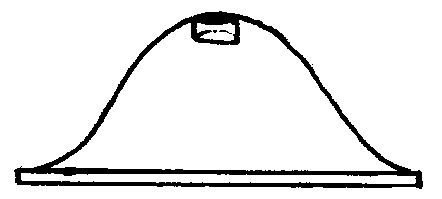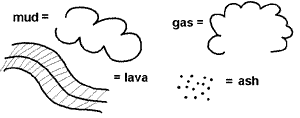BACKGROUND:
Volcanoes are a subject that fascinate young and not
so young students alike. The power and the mystery of a volcanic event is
truly an earthy phenomena. Students sometimes have a difficult time
understanding that the shape of a volcano grows or builds up through time
and it builds from the inside out. Eruption after eruption builds a mountain
like structure,
The various styles of eruptions and magma compositions
build different types of volcanoes. Young children have a difficult time
understanding how an eruption occurs. In this lab, students are asked to
look at analogs for a couple of eruptive styles that may be more familiar to
them. In later grades, students will be exposed to other eruptive styles
Models can help students understand a subject if used
correctly. However, most models are not to scale nor totally correct. In
this exercise students will look at different "models" of a
volcano and try to decide which parts are analogous to a real volcano.
PROCEDURE:
- Build a large volcano model prior to lab.
MATERIALS: large flat wooden surface (2'x 2'), newspaper, Plaster of
Paris(5-7 lbs.), old plastic bucket, spray paint, empty tuna can or jar
with lid. If you wish to make a smaller model, reduce the amount of
materials.
 STEP
1. Crumple up newspapers into balls, and tape them to the wooden surface
in the shape and size of the volcano you plan to build, as drawn to the
right. STEP
1. Crumple up newspapers into balls, and tape them to the wooden surface
in the shape and size of the volcano you plan to build, as drawn to the
right.
 STEP
2. Mix about 5-7 lbs of Plaster of Paris in the bucket with enough water
to form a pasty texture. Mold the Plaster of Paris over the crumpled
paper into the shape of a volcano. Place the tuna can inside the top of
the volcano. See figure to the left. Note - Plaster of Paris
dries very quickly. You have approximately 15-25 minutes to work with it
before it becomes hard. STEP
2. Mix about 5-7 lbs of Plaster of Paris in the bucket with enough water
to form a pasty texture. Mold the Plaster of Paris over the crumpled
paper into the shape of a volcano. Place the tuna can inside the top of
the volcano. See figure to the left. Note - Plaster of Paris
dries very quickly. You have approximately 15-25 minutes to work with it
before it becomes hard.
STEP 3. Allow the volcano to dry completely, then paint and create your
own volcanic scenery.
- Show the students different pictures of volcanoes around the world.
You may use the pictures provided or find pictures from the internet.
- As you show the images, review the parts of volcano. A crater is the
large area at the top; ash is pulverized volcanic rock which can either
be in the air or a coating on the surrounding area, lava flows down the
sides of the volcano; magma is molten rock while it is inside the
volcano; and the vent is the actual opening by which the lava and ash
come out.
- The vocabulary words reflect the different parts of a volcano and some
of the volcanic materials that are erupted. However, note that not all
volcanoes show all of these characteristics at one time. For example, in
1980 Mt. St. Helens ejected ash and volcanic mud, not lava. In contrast,
the ongoing eruptions at Kilauea in Hawaii produce mainly lava.
- Set up the following items at each student station: a) a realistic
model of a volcano; b) toothpaste; c) vinegar, baking soda, and a small
flask in a pan. The realistic model should be made before hand using the
instructions on the following page.
- Demonstrate an "eruption" to the students with the large
model. Erupting the volcano requires that you place about 3 tablespoons
of baking soda in the "crater". Pour about 1/4 cup of vinegar
onto the baking soda in the "crater". The mixture will foam
vigorously, and produce a strong smell.
Another chemical that can be used for the eruption is ammonium
dichromate. This compound must be ignited. It is more visual and a much
better eruption analog, but some scientists feel it maybe carcinogenic.
It can be purchased at a chemical supply house. The ammonium dichromate
produces ash and fire, but also produces a mess!
After you create the volcanic eruption, explain to the students that
the explosion was a model of how some volcanoes erupt. Emphasize that
volcanoes are not all the same. The following diagram can help show
students how to compare the model with a real volcano.
MODEL
(ammonium
dichromate) |
MODEL
(vinegar+
baking soda) |
MT.
ST. HELENS |
HAWAII |
| emits gas |
emits gas |
emits gas |
emits gas |
| smells |
smells |
sulfur odor |
sulfur odor |
| sound |
fizz |
violent |
quiet |
| no fire |
no fire |
no fire |
red hot lava |
| ash |
no ash |
lots of ash |
little ash |
| cone shape |
no shape |
ash cone |
red hot lava |
| ash |
no ash |
lots of ash |
little ash |
| cone shape |
no shape |
ash cone |
lava cone |
- Tell the students that they are going to make their own volcanic
eruptions, using the materials at their stations. Instruct them to
squeeze the tube of toothpaste to cause an "eruption". The
toothpaste inside the tube represents magma, outside it is
"lava". The students should only "erupt" the tube of
toothpaste once.
Next, have the students place a little baking soda in the flask, and
then pour in an appropriate amount of vinegar. The mixture will foam
vigorously, like an explosive eruption. Test this procedure in advance
with your materials; this will determine the appropriate measurements
for baking soda and vinegar to give to your students.
 After they have
completed these experiments, have the students draw a line connecting
the words magma, lava, ash, or mud to its appropriate part of the
picture on their worksheets. On the 4th diagram, have the students draw
a volcano with all of its components. Assist their drawing skills by
putting the symbols to the right on the board. After they have
completed these experiments, have the students draw a line connecting
the words magma, lava, ash, or mud to its appropriate part of the
picture on their worksheets. On the 4th diagram, have the students draw
a volcano with all of its components. Assist their drawing skills by
putting the symbols to the right on the board.
- The important point to emphasize is that models are used to help
understand how real volcanoes work. It will be difficult for the
students to determine whether the right answer in some cases. The
exercise should get students to think about and justify their answers
|